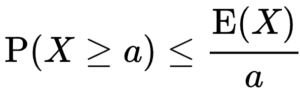Probability and Statistics > Markov’s Inequality gives an upper bound on the probability that a non negative random variable is greater than or equal to some positive constant.
Given a non-negative random variable ![]() and a positive constant
and a positive constant ![]() , Markov’s Inequality states that the probability that
, Markov’s Inequality states that the probability that ![]() is greater than or equal to
is greater than or equal to ![]() must be less than the Expected Value of
must be less than the Expected Value of ![]() divided by
divided by ![]() .
.

Markov’s Inequality is often expressed in a slightly different form, with the constant ![]() being some multiple
being some multiple ![]() of the Expected Value of
of the Expected Value of ![]() .
.
Substituting ![]()
![]()
![]()
![]()
![]() we get:
we get:

With this more familiar form we can look at an interesting and useful application of Markov’s Inequality.
Suppose we wanted to know, what percentage of people make more than 4 times the average income?
Here our non-negative random variable ![]() is income (all income is positive) and the Expected Value of
is income (all income is positive) and the Expected Value of ![]() is the same as the average income
is the same as the average income ![]() , assuming the income distribution is symmetric about the average income.
, assuming the income distribution is symmetric about the average income.
Substituting ![]()
![]()
![]() and
and ![]()
![]()
![]() we get:
we get:

No more than 1/4 of the population (25%) can make more than 4 times the average income.
Intuitively it makes sense that there must be an upper bound for the percentage of people making more than 4 times the average income. If this number were too high (say 80%) the average income itself would be much higher than what it is.
Markov’s Inequality allows us to calculate this upper bound exactly, with the surprisingly simple result that the upper bound is just the reciprocal of the multiple of the average:
- no more than 1/3 of the population can make more than 3 times the average
- no more than 1/5 of the population can make more than 5 times the average
- no more than 1/10 of the population can make more than 10 times the average
- etc…